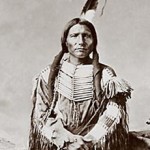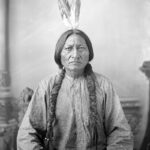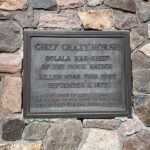
 When the US government decided that the Indians in Montana needed to be moved to their reservations, they resisted by gathering together a combined force of Sioux and Cheyenne warriors and in what became known as the Battle of the Little Bighorn, Crazy Horse and his ally, Sitting Bull along with their men fought to a stunning victory over Lieutenant Colonel George Custer (1839-1876) and his men. Custer faced fierce resistance from Native Americans who opposed the strenuously opposed the US government’s efforts to force them back to their reservations. After Custer and over 200 of his soldiers were killed in the conflict, later dubbed “Custer’s Last Stand,” the white American public demanded revenge. Consequently, the US Army, led by General Nelson Miles (1839-1925), launched a winter campaign in 1876-1877 against the remaining tribes on the Northern Plains.
When the US government decided that the Indians in Montana needed to be moved to their reservations, they resisted by gathering together a combined force of Sioux and Cheyenne warriors and in what became known as the Battle of the Little Bighorn, Crazy Horse and his ally, Sitting Bull along with their men fought to a stunning victory over Lieutenant Colonel George Custer (1839-1876) and his men. Custer faced fierce resistance from Native Americans who opposed the strenuously opposed the US government’s efforts to force them back to their reservations. After Custer and over 200 of his soldiers were killed in the conflict, later dubbed “Custer’s Last Stand,” the white American public demanded revenge. Consequently, the US Army, led by General Nelson Miles (1839-1925), launched a winter campaign in 1876-1877 against the remaining tribes on the Northern Plains.
By combining military force with diplomatic efforts, Nelson persuaded many Native Americans to surrender and return to their reservations. However, much to Miles’ frustration, Sitting Bull refused to capitulate and fled to Canada, where he and his people remained for four years before finally surrendering to the US in 1881. Sitting Bull died in 1890. Meanwhile, Crazy Horse and his band also refused to surrender, despite suffering from illness and starvation.
Six months later, Oglala Lakota Sioux warrior Crazy Horse and his men, who were severely outnumbered, low on ammunition, and forced to use outdated weapons to defend themselves, began the fight that would in essence become Crazy Horse’s Last Stand…or at least his final losing battle against the US Cavalry in Montana. On January 8, 1877, General Miles discovered Crazy Horse’s camp along Montana’s Tongue River. US soldiers opened fire with their large wagon-mounted guns, forcing the Native Americans from their warm tents into a raging blizzard. Crazy Horse and his warriors managed to regroup on a ridge and fire, but most of their ammunition was gone, leaving them to fight with bows and arrows. They held off the soldiers long enough for the women and children to escape under the cover the blinding blizzard before they turned to go with them.
Although Crazy Horse had avoided a decisive defeat, opting instead to retreat, he understood that Miles and his 
 well-equipped cavalry troops would eventually hunt down and destroy his cold, hungry followers. On May 6, 1877, Crazy Horse led approximately 1,100 Native Americans to the Red Cloud reservation near Nebraska’s Fort Robinson and surrendered. Five months later, a guard fatally stabbed him after he allegedly resisted imprisonment by the guards. Very few people believe that story, since it was Crazy Horse who had chosen to surrender. During that time there was a deep level of discord between the Native Americans and the White Man. I’m sure the guard felt that he was doing everyone a favor.
well-equipped cavalry troops would eventually hunt down and destroy his cold, hungry followers. On May 6, 1877, Crazy Horse led approximately 1,100 Native Americans to the Red Cloud reservation near Nebraska’s Fort Robinson and surrendered. Five months later, a guard fatally stabbed him after he allegedly resisted imprisonment by the guards. Very few people believe that story, since it was Crazy Horse who had chosen to surrender. During that time there was a deep level of discord between the Native Americans and the White Man. I’m sure the guard felt that he was doing everyone a favor.


Leave a Reply